How to speed up your metabolism to lose weight: A guide
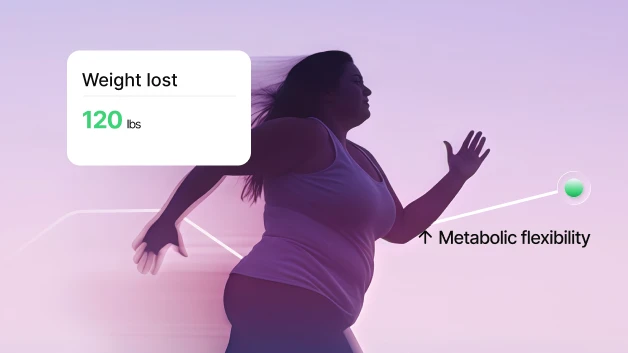
Have you ever felt like you’re doing everything right on your weight loss journey, yet the number on the scale just won’t budge?
You’re not alone.
While one part of the story could be metabolic rate, the bigger part is about your metabolic flexibility.
Metabolism is often likened to an engine that burns fuel. The rate at which this engine operates varies from person to person and can impact weight loss.
A higher metabolic rate (MR) means your body burns more calories even at rest, aiding in weight loss and preventing weight gain [1]. If you have a slow metabolism, your body burns fewer calories to keep it running.
Metabolic flexibility is another critical aspect of your metabolism. It refers to how efficiently the mitochondria, your cells’ powerhouses, switch between burning carbohydrates or fats as a primary energy source [2]. This has many benefits including weight loss that stays off, balanced energy levels, improved fitness performance, and longevity.
Let’s take a closer look at metabolic rate
Your metabolic rate, or total daily energy expenditure (TDEE), consists of your basal metabolic rate (BMR) and thermogenesis.
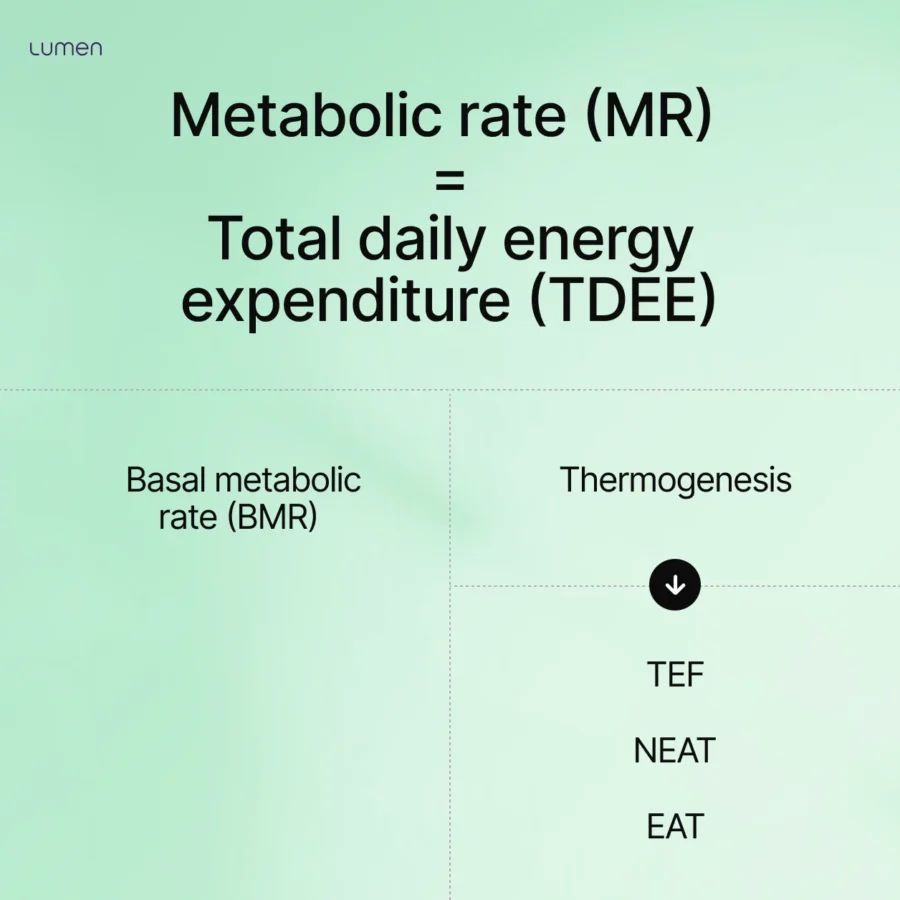
What is BMR?
BMR is the energy your body needs to maintain essential functions, including your heartbeat, breathing, blood circulation, brain function, cell growth, and body temperature regulation. BMR typically accounts for 60-75% of your daily calorie expenditure [3].
Various factors can influence your basal metabolic rate [4], including:
- Body composition and muscle mass
- Gender
- Age
- Hormones
- Genetics
- Environment
What is thermogenesis?
Thermogenesis consists of the three factors below:
- Thermic effect of food (TEF)
TEF is the energy your body needs to digest, absorb, and metabolize food. TEF amounts to 10% of TDEE. For example, if you eat 2000 kcals per day, about 200 kcals will be required to digest, absorb, and transport the nutrients in that meal.
Physical activity:
- Exercise activity thermogenesis (EAT)
EAT is the energy your body needs to power workouts like walking, cycling, and weightlifting, accounting for 15-30% of TDEE.
- Non-exercise activity thermogenesis (NEAT)
NEAT powers non-exercise-based activities, including walking around the office, standing, climbing a few stairs, and doing chores [5]. NEAT accounts for 15-50% of TDEE.
Some parts of your metabolic rate can’t be changed (e.g., age, gender, genetics, etc.). However, metabolic rate is not static. You can influence some areas, including muscle mass, TEF, EAT, and NEAT, just like your metabolic flexibility.
Let’s dive into some nutrition and fitness strategies to improve your metabolic rate and metabolic flexibility.
Nutrition strategies to boost your metabolic rate and metabolic flexibility
Metabolic rate toolbox
Avoid extreme calorie restriction
While you need to achieve a caloric deficit to lose weight, it is best to do so through modest caloric restriction. Due to a survival mechanism called metabolic adaptation, extreme calorie restriction will eventually cause your BMR to decrease to match the reduced calorie intake [6].
Avoiding extreme calorie reduction can minimize drops in BMR and result in more sustainable weight loss.
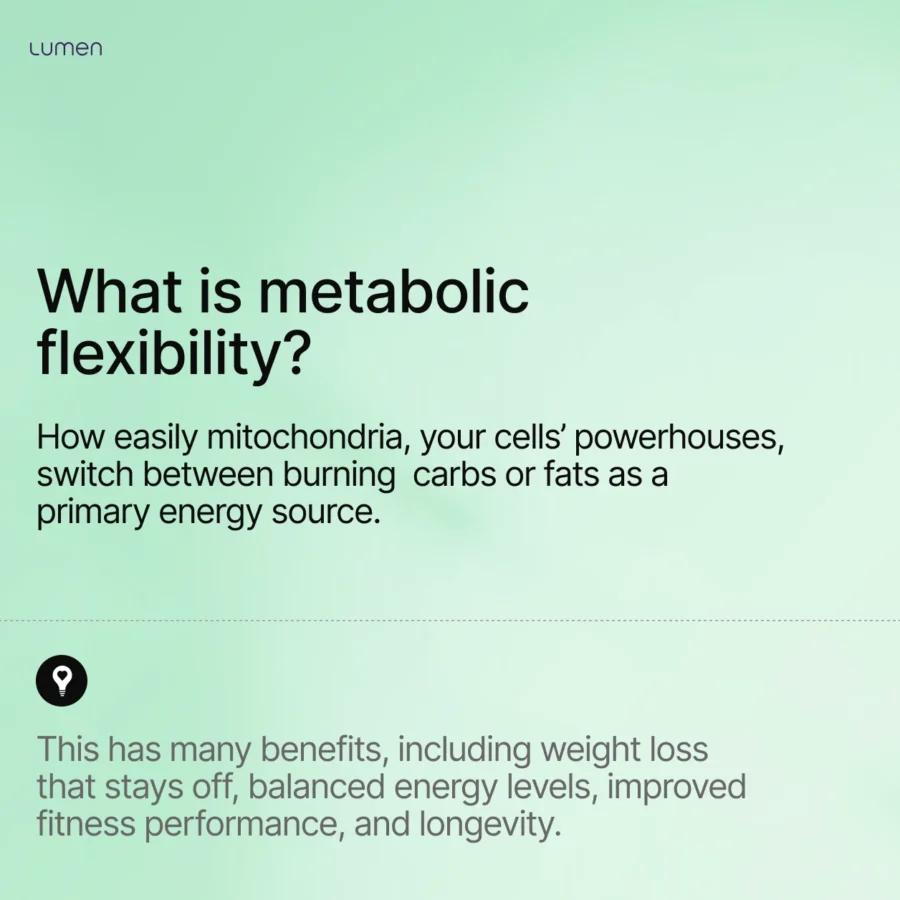
Eat more protein
Protein has the highest thermic effect of the three macros compared to carbs and fat [7].
To compare:
Thermic effect of protein: 15-30%
Thermic effect of carbohydrates: 5-10%
Thermic effect of fat: 0-3%
According to research, two meals with the same amount of calories but different amounts of protein will affect metabolism differently, with the higher protein meal resulting in a higher TEF [8]. Consuming adequate protein at each meal can maximize your daily calorie output.
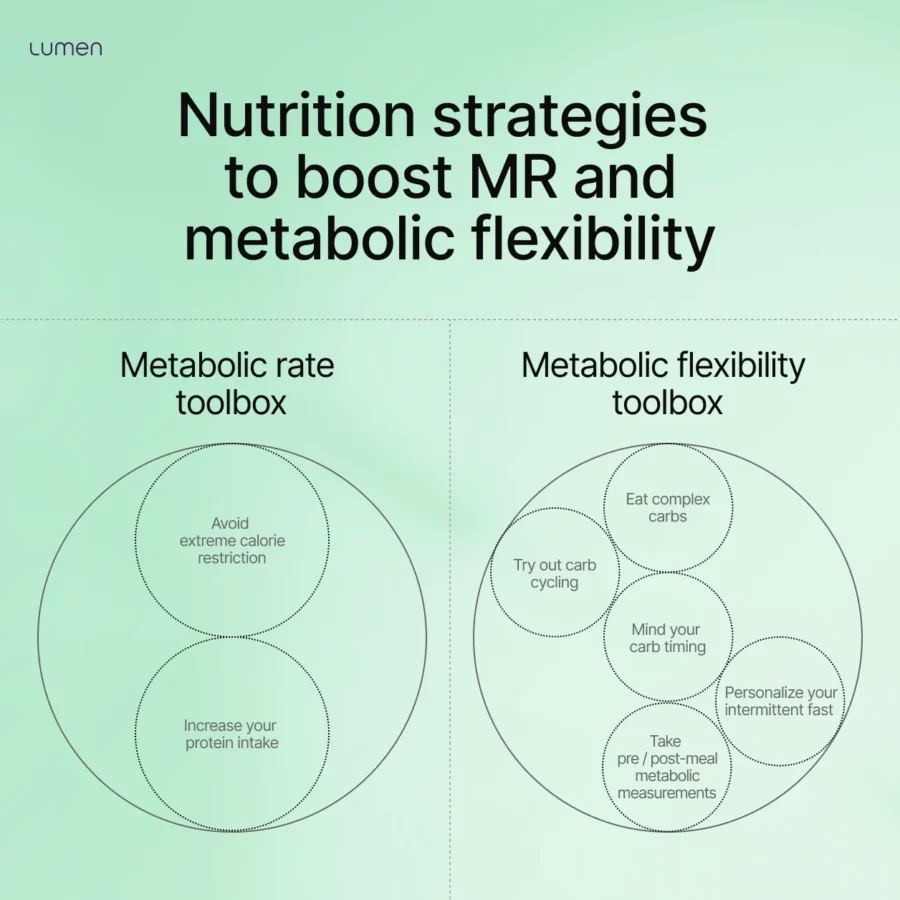
Metabolic flexibility toolbox
Manage your carbs
While all carbs can be a fuel source for your mitochondria, the quality of the carbs you consume plays a significant role in how they affect your health and metabolism. Carbohydrates come in many forms, but the two main types are complex and simple.
Nutrient-dense complex carbohydrates — like whole grains, fruits, and vegetables — help stabilize blood sugar, improve insulin sensitivity, and provide sustained energy. On the other hand, simple carbs — such as refined sugary snacks and white bread — can lead to blood sugar spikes, energy crashes, and long-term metabolic imbalances [9].
Eating adequate carbs is key for metabolic flexibility, although timing is key. Eating carbs earlier in the day ensures your mitochondria don’t burn carbs overnight and can switch to fat burn. During rest, fat is the preferred fuel source for your mitochondria’s maintenance, repair, and reproduction. Moreover, eating carbs around high-intensity or prolonged exercise helps your mitochondria use them for fuel instead of storing them as fat.
Carb cycling is another great way to boost your metabolic flexibility. High-carb days allow your body to replenish glycogen stores in your muscle tissue for improved exercise performance and recovery [10]. Low-carb days help you tap into your glycogen reserves and fat stores for energy instead of relying on carbs for fuel. Using a metabolism tracker like Lumen can help you identify which days to eat low carb versus high carb.
Intermittent fasting
When intermittent fasting, the mitochondria shift from using glucose as a primary energy source in the fed state to glycogen, the storage form of carbs, and finally, stored body fat. This shift from carb to fat burn helps boost metabolic flexibility.
However, there is such a thing as fasting for too long. Overextending a fast can cause the body to release stress hormones, such as cortisol, in response to the perceived lack of energy intake. These stress hormones can push the mitochondria into a state of carbohydrate metabolism, where they prioritize burning carbs over fats for energy. This arises from the body’s attempt to preserve fat stores if overextended fasting continues.
Finding your ideal fasting window is important for metabolic flexibility, and you can do so by measuring your metabolism throughout your fast. For example, if you measure your metabolism after 12 hours of fasting and find you’re burning fats, try extending your fast and measuring your metabolism every 1-2 hours to determine what your mitochondria are burning for energy. If you continue burning fat, this may indicate that your glycogen stores are emptying and your fast is effective. If you’ve shifted back to carb burn, then you’ve passed your fasting sweet spot. That’s a sign to end your fast and eat something nutritious.
Pre- and post-meal breath
Your pre-meal breath can reveal your current glycogen levels, helping you figure out how many carbs to eat at your next meal.
Glycogen levels depend on your carb intake and energy use. When glycogen is high, your mitochondria focus on burning carbs. If you eat more carbs than your glycogen stores can hold, the excess is stored as fat.
If you’re burning mostly carbs before a meal, your glycogen stores are likely full. Choose a low-carb meal with protein, healthy fats, and veggies to avoid glycogen overload and weight gain. If your pre-meal breath shows fat burn or a fat-carb mix, your glycogen stores aren’t full. You can eat carbs, if you’d like, without risking overload.
Take a post-meal breath 45–90 minutes after eating to see how your body responds to the meal. Your shift to carb burn may be sharp or gradual.
In a retrospective study by Lumen with 2,607 participants, people with a healthy BMI and better metabolic flexibility demonstrated a greater post-meal carb response, burning more of the carbs they ate for energy rather than storing them as fat [11].
This aligns with results from our latest Lumen Experiments, involving 2,700 Lumen community members, which showed that participants with a BMI of 18.5–25 demonstrated:
- A faster and stronger carb response after eating. This means they are more likely to use the carbs they eat for energy rather than store them as fat.
- Higher CO2 levels even 2+ hours after eating, indicating more metabolic activity.
Fasting breath
Measure your metabolism to know when to break your fast. Begin by measuring your metabolism when you first wake up to establish a baseline and determine whether you’re burning carbs or fats for fuel.
Continue measuring your metabolism every hour. The goal is to remain at level 1 or 2, which indicates fat burn. During a fast, your mitochondria should be burning fat for fuel.
When you shift towards carb burn (level 4 or 5), this indicates you should break your fast, as your glycogen stores are getting critically low and leading your body to break down muscle for energy.
Functional nutrition
Omega-3 fatty acids can help support insulin sensitivity, primarily due to their anti-inflammatory effects.
Chronic low-grade inflammation plays a key role in the development of insulin resistance. Omega-3 fatty acids, especially EPA and DHA, help lower this inflammation by lowering the levels of inflammatory molecules. This reduces stress on insulin receptors, improving their ability to respond to insulin and allowing cells to take up glucose effectively.
Omega-3 fatty acids also indirectly reduce oxidative stress by lowering the production of free radicals through their anti-inflammatory effects.
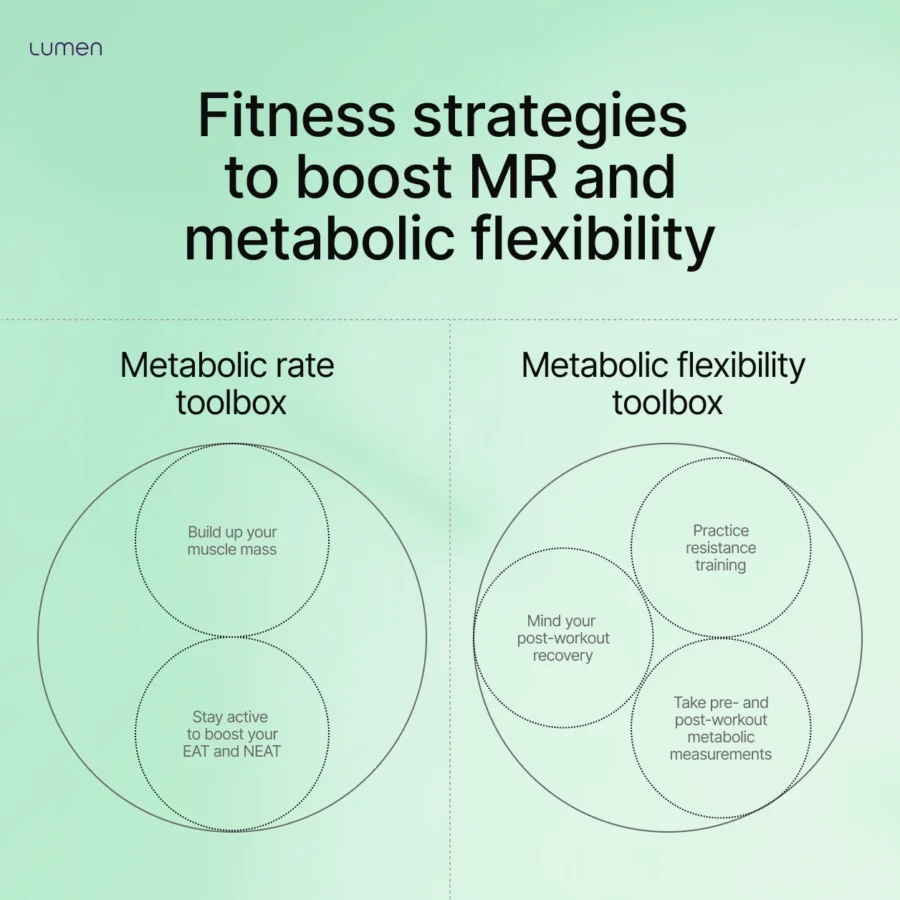
Fitness strategies to boost your metabolic rate and metabolic flexibility
Metabolic rate toolbox
Muscle mass
Body composition plays a significant role in determining your metabolic rate. Muscle mass requires a lot of energy to maintain compared to fat mass. The more muscle you have, the higher your BMR will be, as muscle tissue burns more calories at rest than fat tissue. This is why strength training and other muscle-building exercises are critical for anyone looking to boost their metabolism.
In one study, 10 weeks of resistance training resulted in a 7% increase in BMR [12]. Lumen’s metabolic coaches recommend strength training, such as weightlifting or bodyweight exercises, to increase muscle mass and improve metabolic health.
Stay active to boost EAT and NEAT
You can increase your EAT by engaging in intentional exercise like running, strength training, and biking. To boost your NEAT, take the stairs instead of an escalator, stand more at work rather than sit, or walk instead of taking the bus.
Physical activity has the greatest variability of total daily energy expenditure and can be adapted in different ways to increase your metabolic rate.
Metabolic flexibility toolbox
Muscle mass
Building and maintaining your muscle mass is just as important for metabolic flexibility.
Your muscles are packed with mitochondria and house most of your glycogen, your body’s glucose storage. This means the more muscle mass you gain, the more mitochondria and glycogen stores you’ll have.
As a result, your muscles can efficiently use carbs when you need an energy boost, ensuring less glucose is stored as fat. It also helps your mitochondria better metabolize fat at rest or during low-intensity activities.
Measure your pre- and post-workout breaths
Take a pre-workout breath measurement to determine if you should fuel up before your high-intensity workout. If you’re burning fat, that’s a sign your glycogen stores are low, and you should eat a fast-digesting carbohydrate source like a banana to avoid muscle breakdown.
Take a metabolic measurement again 30–45 minutes following your workout, after your heart rate has stabilized. This measurement gauges how intense your exercise was and how well your body is recovering.
During high-intensity workouts like sprinting or weightlifting, your mitochondria rely on carbs for a quick and powerful energy boost. Afterward, your body enters a recovery phase, replenishing glycogen stores and repairing muscle tissue. During this time, it burns mostly carbs.
Once you’ve shifted to fat burn, it means recovery is complete. A longer shift back to fat burn means you had an intense workout.
Mind your recovery
Building and maintaining muscle isn’t only about what you do at the gym but also about how you recover after. Proper recovery gives your muscles time to heal and grow while keeping the risk of injury low and boosting your performance.
These are some supports that can help with your post-workout recovery:
Get quality sleep
During sleep, the body releases growth hormone, stimulating insulin-like growth factor hormone (IGF-1), which helps repair microtears in muscle fibers caused by exercise [13]. Sleep also supports protein synthesis, which is vital for muscle repair and growth [14].
Neutralize free radicals with CoQ10
CoQ10 is a powerful antioxidant that supports mitochondrial function and helps reduce oxidative stress caused by exercise. During intense physical activity, mitochondria produce energy, but this process also generates reactive oxygen species (ROS), which can lead to muscle fatigue and damage [15].
CoQ10 plays a crucial role in neutralizing these free radicals while supporting ATP production, aiding in muscle recovery and overall endurance. Studies show that CoQ10 may reduce exercise-induced muscle damage, improve power output, and alleviate post-workout soreness. Natural sources of CoQ10 include fatty fish, spinach, nuts, and cauliflower, which help protect mitochondria from oxidative stress and support recovery.
Add in magnesium
Magnesium is vital for muscle relaxation and nerve function. Adequate magnesium intake has been associated with improved muscle function and reduced cramps, potentially aiding recovery [16]. In addition to supporting your workouts, magnesium plays a key role in improving sleep quality, which is essential for muscle repair and overall recovery.
A whole-body approach to speeding up metabolism
Speeding up your metabolism for weight loss involves more than metabolic rate; it’s a holistic approach that includes boosting your metabolic flexibility.
Minding your carbs, intermittent fasting, fitness, and building muscle mass can all improve your metabolic health.
Remember, the key to sustainable weight loss isn’t drastic diets or intense exercise regimens but a consistent, balanced lifestyle.
Sources
[1] Judge, A., & Dodd, M. S. (2020). Metabolism. Essays in biochemistry, 64(4), 607–647. https://doi.org/10.1042/EBC20190041
[2] Smith, R. L., Soeters, M. R., Wüst, R. C. I., & Houtkooper, R. H. (2018). Metabolic Flexibility as an Adaptation to Energy Resources and Requirements in Health and Disease. Endocrine reviews, 39(4), 489–517. https://doi.org/10.1210/er.2017-00211
[3] Fonseca, D. C., Sala, P., De Azevedo Muner Ferreira, B., Reis, J., Torrinhas, R. S., Bendavid, I., & Linetzky Waitzberg, D. (2018). Body weight control and energy expenditure. Clinical Nutrition Experimental, 20, 55-59.
[4] Martin, C. R., Preedy, V. R., & Abbatecola, A. M. (2015). Diet and nutrition in dementia and cognitive decline. Academic Press.
[5] Chung, N., Park, M. Y., Kim, J., Park, H. Y., Hwang, H., Lee, C. H., Han, J. S., So, J., Park, J., & Lim, K. (2018). Non-exercise activity thermogenesis (NEAT): a component of total daily energy expenditure. Journal of exercise nutrition & biochemistry, 22(2), 23–30. https://doi.org/10.20463/jenb.2018.0013
[6] Most, J., & Redman, L. M. (2020). Impact of calorie restriction on energy metabolism in humans. Experimental gerontology, 133, 110875. https://doi.org/10.1016/j.exger.2020.110875
[7] Pesta, D. H., & Samuel, V. T. (2014). A high-protein diet for reducing body fat: mechanisms and possible caveats. Nutrition & metabolism, 11(1), 53. https://doi.org/10.1186/1743-7075-11-53
[8] Calcagno, M., Kahleova, H., Alwarith, J., Burgess, N. N., Flores, R. A., Busta, M. L., & Barnard, N. D. (2019). The Thermic Effect of Food: A Review. Journal of the American College of Nutrition, 38(6), 547–551. https://doi.org/10.1080/07315724.2018.1552544
[9] Holesh, J. E. (2023, May 12). Physiology, carbohydrates. StatPearls [Internet]. https://www.ncbi.nlm.nih.gov/books/NBK459280/
[10] Ivy J. L. (2004). Regulation of muscle glycogen repletion, muscle protein synthesis and repair following exercise. Journal of sports science & medicine, 3(3), 131–138.
[11] Yeshurun, S., Cramer, T., Souroujon, D., & Mor, M. (2024). The Association of Macronutrient Consumption and BMI to Exhaled Carbon Dioxide in Lumen Users: Retrospective Real-World Study. JMIR mHealth and uHealth, 12, e56083. https://doi.org/10.2196/56083
[12] Westcott W. L. (2012). Resistance training is medicine: effects of strength training on health. Current sports medicine reports, 11(4), 209–216. https://doi.org/10.1249/JSR.0b013e31825dabb8
[13] Chennaoui, M., Vanneau, T., Trignol, A., Arnal, P., Gomez-Merino, D., Baudot, C., Perez, J., Pochettino, S., Eirale, C., & Chalabi, H. (2021). How does sleep help recovery from exercise-induced muscle injuries?. Journal of science and medicine in sport, 24(10), 982–987. https://doi.org/10.1016/j.jsams.2021.05.007
[14] Lamon, S., Morabito, A., Arentson-Lantz, E., Knowles, O., Vincent, G. E., Condo, D., Alexander, S. E., Garnham, A., Paddon-Jones, D., & Aisbett, B. (2021). The effect of acute sleep deprivation on skeletal muscle protein synthesis and the hormonal environment. Physiological reports, 9(1), e14660. https://doi.org/10.14814/phy2.14660
[15] Hidalgo-Gutiérrez, A., González-García, P., Díaz-Casado, M. E., Barriocanal-Casado, E., López-Herrador, S., Quinzii, C. M., & López, L. C. (2021). Metabolic Targets of Coenzyme Q10 in Mitochondria. Antioxidants (Basel, Switzerland), 10(4), 520. https://doi.org/10.3390/antiox10040520
[16] Liguori, S., Moretti, A., Paoletta, M., Gimigliano, F., & Iolascon, G. (2024). Role of Magnesium in Skeletal Muscle Health and Neuromuscular Diseases: A Scoping Review. International journal of molecular sciences, 25(20), 11220. https://doi.org/10.3390/ijms2520112




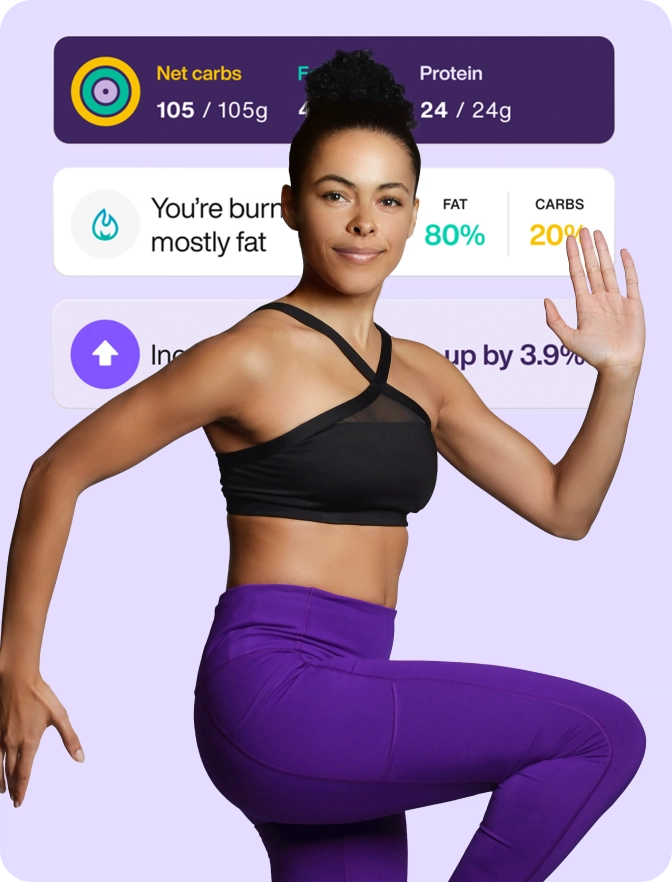


 Digital download
Digital download 


